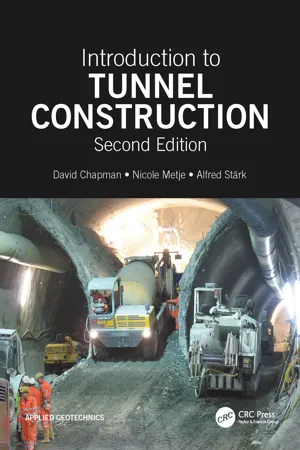
- 425 pages
- English
- ePUB (mobile friendly)
- Available on iOS & Android
Introduction to Tunnel Construction
About This Book
Tunnelling provides a robust solution to a variety of engineering challenges. It is a complex process, which requires a firm understanding of the ground conditions as well as the importance of ground-structure interaction. This book covers the full range of areas related to tunnel construction required to embark upon a career in tunnelling. It also includes a number of case studies related to real tunnel projects, to demonstrate how the theory applies in practice. New features of this second edition include: the introduction of a case study related to Crossrail's project in London, focussing on the Whitechapel and Liverpool Street station tunnels and including considerations of building tunnels in a congested urban area; and further information on recent developments in tunnel boring machines, including further examples of all the different types of machine as well as multi-mode machines.
The coverage includes:
-
- Both hard-rock and soft-ground conditions
-
- Site investigation, parameter selection, and design considerations
-
- Methods of improving the stability of the ground and lining techniques
-
- Descriptions of the various main tunnelling techniques
-
- Health and safety considerations
-
- Monitoring of tunnels during construction
-
- Description of the latest tunnel boring machines
-
- Case studies with real examples, including Crossrail's project in London
Clear, concise, and heavily illustrated, this is a vital text for final-year undergraduate and MSc students and an invaluable starting point for young professionals and novices in tunnelling.
Frequently asked questions
Information
| Above ground construction | Tunnel construction | |
| Construction material | The defined properties of the construction materials are guaranteed by the quality control procedures during the production process, including control testing | The ground, with all its uncertainty, and the general inability to influence its properties (notwithstanding ground improvement techniques) is the construction material |
| Loads | The loads for which the structural analysis is carried out are mostly known | Only by making assumptions is it possible to estimate the loads, which means that the magnitude of the load is based on assumption and is thus basically unknown |
| Safety | Since the properties of the construction materials and the loads are known, the safety factor relative to failure can be determined | Owing to the number of uncertainties related to the loads and material properties, it is not possible to calculate a quantitative factor regarding the safety of the tunnel construction |
| Source:Institute for Geotechnical Engineering, Department for Tunnelling and Underground Construction, Hanover University, Germany. | ||
Table of contents
- Cover
- Half Title
- Title Page
- Copyright Page
- Disclaimer
- Dedication
- Contents
- Abbreviations
- Symbols
- Preface to the second edition
- Preface to the first edition
- Acknowledgements and permissions
- Authors
- 1. Introduction
- 2. Site investigation
- 3. Preliminary analyses for the tunnel
- 4. Ground improvement techniques and lining systems
- 5. Tunnel construction techniques
- 6. Health and safety, and risk management in tunnelling
- 7. Ground movements and monitoring
- 8. Case studies
- References
- Appendix A: Further information on rock mass classification systems
- Appendix B: Analytical calculation of a sprayed concrete lining using the continuum method
- Index